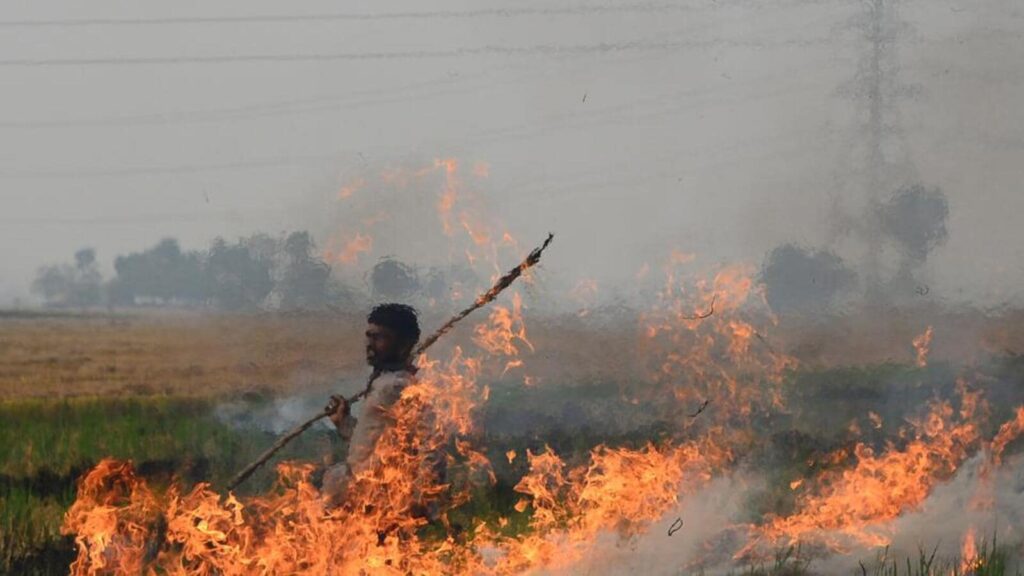Centre doubles fine forburning farm stubble | Latest News Delhi

The Union government has doubled the fines issued against farmers for burning stubble up to ₹30,000, depending on the size of their plots, in a last-minute bid to stop the annual scourge that drives up Delhi’s winter pollution into hazardous levels, even as the city’s air quality index (AQI) spiralled to the upper reaches of the “very poor” zone on Thursday.
 ₹5,000 for each incidence of stubble burning incidence, up from ₹2,500. (ANI)” title=”According to these rules, farmers with plots smaller than two acres will be fined ₹5,000 for each incidence of stubble burning incidence, up from ₹2,500. (ANI)” />
₹5,000 for each incidence of stubble burning incidence, up from ₹2,500. (ANI)” title=”According to these rules, farmers with plots smaller than two acres will be fined ₹5,000 for each incidence of stubble burning incidence, up from ₹2,500. (ANI)” />The Commission for Air Quality Management in the National Capital Region and Adjoining Areas (Imposition, Collection, and Utilization of Environmental Compensation for Stubble Burning) Amendment Rules, 2024, were notified on Wednesday, and were made public on Thursday.
On the same day, the Commission for Air Quality Management (CAQM) also issued an order, asking for states to implement the directions and revised environmental compensation needs to be imposed with immediate effect.
“The Commission through its order dated November 7 has authorized all nodal/supervisory officers appointed by the respective governments in the National Capital Territory of Delhi, state of Punjab, state of Haryana and the NCR areas of Rajasthan and Uttar Pradesh to impose and collect Environmental Compensation (EC) from farmers causing air pollution by stubble burning, as per the revised rates. This order is required to be implemented by the respective state governments with immediate effect,” the statement said.
According to these rules, farmers with plots smaller than two acres will be fined ₹5,000 for each incidence of stubble burning incidence, up from ₹2,500.
Those with plots larger than two acres but smaller than five will be fined ₹10,000 and cultivators with over five acres of land will have to pay ₹30,000 per incidence.
The rules were first notified in 2023.
The notification also provides a format to impose fines on farmers for burning crop stubble. These include requiring state officials to note down details of the farmer including his name, house number, street, village, tehsil, district, contact details, land details (including khasra, khewat and khatoni numbers), along with the estimated area. The EC will also have to have the farmer’s signature.
The move came at a time when the air quality in the Capital is spiralling downwards — it was 377 in the 4pm bulletin by the Central Pollution Control Board on Thursday, and by 10pm had deteriorated to 382 (24-hour average), the cusp of the “severe” zone that starts from 400.
Farmers in north India set fire to their paddy stubble after the season’s harvest to clear their plots ahead of the winter crop. However, the smoke from these fires travel hundreds of kilometres towards Delhi and the National Capital Region (NCR), sheathing the area in a grey haze and exposing even healthy people to a raft of hazardous illnesses.
Last year, Punjab recorded 36,632 across the state between September 15 and November 15. It clocked 49,922 in 2022, 71,159 in 2021, 83,002 in 2020 and 55,210 in 2019.
CAQM, despite queries by HT, did not share data or comment on the fines issued so far.
Farmers however insisted that they needed government assistance to wean out the practice.
Harinder Singh, state president of the Bhartiya Kisan Union (Lakhowal) in Punjab, said farm fires cases “were declining.”
“Farmers are willing to cooperate and they simply need assistance. Even now, we are not receiving any subsidies and it is the smaller farmers – with land less than two acres – who are suffering. Not all of them are getting access to machines that remove paddy stubble. Moreover, it is difficult to use these machines to remove stubble in smaller fields,” he said.
Others also said farmers should be incentivised, rather than penalised.
“Richer farmers with bigger plots are able to get machines and can even pay for bailors to lift residue. Smaller farmers are the ones burning their leftover residue now and they are the ones who are likely to suffer. We are calling for financial assistance, of around ₹200 per quintal of paddy stubble sold,” said Balkarn Brar, State President of the All India Kisan Sabha (AIKS) in Bathinda, Punjab.
Experts said stubble management plans need to be more holistic.
“It is more important to have enablers. For example, farmers should have access to straw management machinery on time so the roster should be well managed. There are two ways of managing stubble — in situ where the straw is utilised in the farm and ex-situ management where the stubble is transported out to make pellets etc. For ex situ strategies storage and transportation support is needed. For example, after CAQM prohibited the use of coal as a fuel in the NCR, the use of biomass has increased and price has also increased. But farmers are not benefitting from this because storage and transportation remain challenges,” said Anumita Roychowdhury, executive director, Centre for Science and Environment.
Delhi’s AQI has been over 300 (very poor) since October 30. The contribution of stubble burning to Delhi’s PM 2.5, tiny particles with a diameter of 2.5 micrometers or less, was 20.3% on Tuesday, according to data from the Decision Support System calculated based on the actual fire counts. It was 23.3% a day earlier. On November 1, farm fires were estimated to have contributed a season-high of 35.1% of Delhi’s PM 2.5 load.




